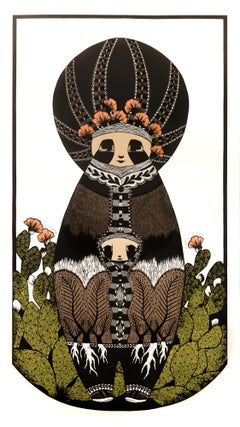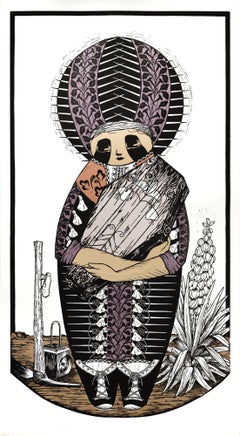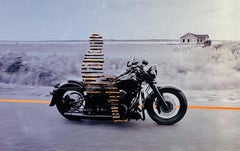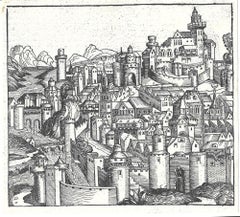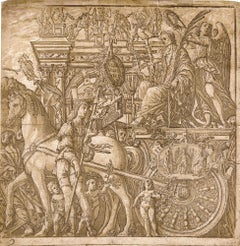Dye Figurative Prints
to
1
2
Overall Width
to
Overall Height
to
3
1
3
2
1
2
2
2
1
1
1
1
1
1
1
1
1
263
16,914
12,377
6,326
3,231
1
1
3
Medium: Dye
"The Mother", Figurative, Woodcut, Hand Dyed Paper
Located in Philadelphia, PA
This piece titled "The Mother" is an original print by Annalise Gratovich and is made from woodcut with hand dyed paper. This piece measures 71"h x 39.5"w unframed.
Annalise Gratovich is a print-centric artist living and working in Austin, Texas. She specializes in large scale woodcuts, etchings, and collage. Annalise’s work investigates her identity as the second generation daughter of a Ukrainian war...
Category
21st Century and Contemporary Contemporary Dye Figurative Prints
Materials
Dye, Woodcut, Ink, Paper
"The Undertaker", Figurative, Woodcut Print on Hand Dyed Paper
Located in Philadelphia, PA
This piece titled "The Undertaker" is an original print by Annalise Gratovich and is made by woodcut on hand-dyed paper. This piece measures 71.5"h x 38.75"w unframed.
Annalise Gratovich is a print-centric artist living and working in Austin, Texas. She specializes in large scale woodcuts, etchings, and collage. Annalise’s work investigates her identity as the second generation daughter of a Ukrainian war...
Category
21st Century and Contemporary Contemporary Dye Figurative Prints
Materials
Paper, Woodcut, Ink, Dye
Harley in the Hamptons by Award Winning Photographer David Gamble
By David Gamble
Located in Chicago, IL
Harley in the Hamptons
Dye Sublimation on Aluminum
19 x 30 inches
Edition size: 10
About the artist:
David Gamble is a multidisciplinary artist from London, now based in New Orl...
Category
21st Century and Contemporary Contemporary Dye Figurative Prints
Materials
Metal
Related Items
Tolosa (Toulouse); Leaf LXXI from Hartmann Schedel's Nuremberg Chronicle
Located in Middletown, NY
Woodcut on laid paper, 8 3/8 x 9 1/8 inches (212 x 233 mm), the full sheet. In excellent condition with text and portraits of Empedocles, Sapho, Zeuxis and others on the verso, as is...
Category
15th Century and Earlier Old Masters Dye Figurative Prints
Materials
Ink, Handmade Paper, Laid Paper, Woodcut
The Triumph of Caesar: Plate IV of IX
By Andrea Mantegna
Located in Middletown, NY
Andreani, Andrea, after Andrea Mantegna
The Triumph of Caesar: Plate IV of IX
1599. Chiaroscuro woodcut in colors printed from four blocks on laid paper in dark brown, grey, and thr...
Category
16th Century Old Masters Dye Figurative Prints
Materials
Handmade Paper, Laid Paper, Ink, Woodcut
Seishi Ai-oi Genji – Set of 12 Shunga works together w/astrological commentary
Located in Middletown, NY
Set of 12 woodblock prints in colors on handmade, laid mulberry paper, 6 3/4 x 10 1/4 inches (170 x 258 mm), printed in Ka-ei 4 (1851). Each print with minor handling wear, otherwise in excellent condition with bright and fresh color, and with details printed in silver ink. The images themselves contain several illusive characters indicating the publisher which are obfuscated by figures, as intended. Presented loose, as issued. A fine set.
The astrological commentary print has a large and meandering blind stamp with a bird and palm frond motif. This print lists various phrases concerning the Twelve Zodiac Animals as historically counted in Japan, and appears to include erotic commentary on the traits of people born under each of the twelve signs.
These Shunga images were issued in books that paralleled (in an erotic fashion...
Category
Mid-19th Century Edo Dye Figurative Prints
Materials
Handmade Paper, Ink, Woodcut
Elegant Amusements of Eastern Genji - Japanese Triptych Woodblock Print on Paper
Located in Soquel, CA
Elegant Amusements of Eastern Genji - Japanese Triptych Woodblock Print on Paper
Dynamic woodblock print with several elegantly dressed figures by Utag...
Category
1850s Edo Dye Figurative Prints
Materials
Paper, Ink, Woodcut
$1,550
H 22.5 in W 32.5 in D 1 in
Jose Luis Cuevas original artist proof signed woodcut Ghosts of downtown V paper
Located in Miami, FL
Jose Luis Cuevas (Mexico, 1934-2017)
Artist Proof
'Fantasmas del Centro Histórico V', 2004
woodcut on paper Guarro Biblos 250g.
20.9 x 16 in. (53 x 40.5 cm.)
Edition of 60
Unframed
I...
Category
Early 2000s Contemporary Dye Figurative Prints
Materials
Paper, Woodcut, Ink
The Triumph of Caesar: Plate IV
By Andrea Mantegna
Located in Middletown, NY
Andreani, Andrea (Italian, about 1558–1610), after Andrea Mantegna (Italian, 1431-1506)
Chiaroscuro woodcut in colors printed from four blocks on laid paper in dark brown, grey, and...
Category
16th Century Old Masters Dye Figurative Prints
Materials
Ink, Handmade Paper, Laid Paper, Woodcut
"Dawn Inside the Yoshiwara" Utagawa Hiroshige, Japanese Landscape, Ukiyo-e
Located in New York, NY
Utagawa Hiroshige
Dawn Inside the Yoshiwara, circa 1857
Woodblock print
11 x 7 inches
Utagawa Hiroshige is recognized as a master of the ukiyo-e woodblock printing tradition, havin...
Category
1850s Naturalistic Dye Figurative Prints
Materials
Paper, Ink, Woodcut
"Malibu's Most Wanted Pt. 2" Photography 16" x 24" in Ed. of 15 by Brendan North
Located in Culver City, CA
"Malibu's Most Wanted Pt. 2" Photography 16" x 24" in Ed. of 15 by Brendan North
Available sizes:
Edition of 15: 16" x 24" inch
Edition of 7: 24" x 36" inch
Edition of 3: 40" x 60" ...
Category
21st Century and Contemporary Contemporary Dye Figurative Prints
Materials
Digital, Archival Paper
$1,550
H 16 in W 24 in D 0.1 in
"Target Practice" Photography 30" x 24" inch Edition of 7 by Brendan North
Located in Culver City, CA
"Target Practice" Photography 30" x 24" inch Edition of 7 by Brendan North
Not Framed
Ships rolled in a tube
ABOUT:
Brendan North is a fine art photographer based in Los Angeles. H...
Category
21st Century and Contemporary Contemporary Dye Figurative Prints
Materials
Digital, Archival Paper
$2,100
H 30 in W 24 in D 0.1 in
"Encuentro" 2006 Original Unique Signed Artist Proof 28x20in Woodcut Mexican
Located in Miami, FL
Antonio Diaz Cortes (Mexico, 1935)
'Encuentro' (meeting), 2006
woodcut on paper Velin Arches 300 g.
27.6 x 19.7 in. (70 x 50 cm.)
P/A (Artist Proof), unique piece
Unframed
ID: DIA-10...
Category
Early 2000s Contemporary Dye Figurative Prints
Materials
Engraving, Woodcut, Ink, Linocut
Cuban signed limited edition original art print women woodcut 151
Located in Miami, FL
Luis Miguel Valdes (Cuba, 1949)
'Torso I', 2006
woodcut on paper Guarro Biblos 250g.
18.6 x 11.1 in. (47 x 28 cm.)
Edition of 20
Unframed
ID: 1G200613
Hand-signed by author
_________...
Category
Early 2000s Contemporary Dye Figurative Prints
Materials
Woodcut, Ink
$175
H 18.6 in W 11.1 in
"Armed and Dangerous" Photography 16" x 24" inch Edition of 15 by Brendan North
Located in Culver City, CA
"Armed and Dangerous" Photography 16" x 24" inch Edition of 15 by Brendan North
Available sizes:
Edition of 15: 16" x 24" inch
Edition of 7: 24" x 36" inch
Edition of 3: 40" x 60" i...
Category
21st Century and Contemporary Contemporary Dye Figurative Prints
Materials
Archival Paper, Digital
$1,550
H 16 in W 24 in D 0.1 in
Dye figurative prints for sale on 1stDibs.
Find a wide variety of authentic Dye figurative prints available on 1stDibs. While artists have worked in this medium across a range of time periods, art made with this material during the 21st Century is especially popular. There are many well-known artists whose body of work includes ceramic sculptures. Frequently made by artists working in the Contemporary, all of these pieces for sale are unique and many will draw the attention of guests in your home. Not every interior allows for large Dye figurative prints, so small editions measuring 0.04 inches across are also available
